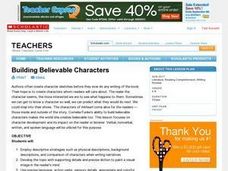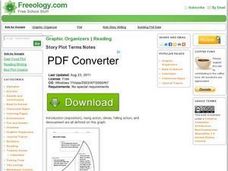Curated OER
Character's Motive
Why do people commit crimes? Middle schoolers investigate characters' motives for committing a crime in a character analysis lesson. First, they read the book Chasing Vermeer and identify the suspects. They then record the details about...
Curated OER
Good and Evil Characters
What makes a character good or evil? Young readers discuss the characteristics and actions of good and evil characters in given fairy tales. They then read Snow White and discuss the characters in the story.
Curated OER
Biopoem
Reinforce the actions, emotions, and characteristics that determine what a character is like by having your middle schoolers create a biopoem using the model presented here. You could engage them first by having them write a poem about...
Curated OER
Creating Characters: Movement
Students compare two characters and role-play how they would perform various actions. They view and discuss a video, list opposite descriptions for the two girls in the video, and role-play the opposites.
Curated OER
Say It Like A Character
Students read a story and retell it to the class by role-playing one of the characters. In groups, they use the correct facial expressions along with body language and voice to convince the others in their group that they are actually...
Polk Bros Foundation
I Can Infer Motives
Why did they do it? Get to the bottom of complex characters and people by analyzing their motivation. Learners select an action and take a close look at that action in order to infer motive. They then explain why they determined that...
Polk Bros Foundation
I Can Identify/Infer Motive
Why do people and characters act as they do? Require your class figure out the motivation of two people or characters they read about in a given text. In the short charts, pupils note down who, what they do, and why they do it. After...
Curated OER
Seedfolks
Students explore sequencing. In this sequencing lesson, students sequence events to analyze character actions as cause and effect or the plot of the story. Students discuss character actions and list them on a chart.
Curated OER
Building Believable Characters
Students use descriptive strategies such as physical descriptions, background, and comparison of characters when writing narratives. They develop the topic with supporting details and precise diction to paint a visual image in the...
Curated OER
Write a Scene
In this write a scene instructional activity, students examine a snowy scene picture and then write about their ideas for the setting, characters, actions and events of the pictured scene.
Curated OER
Describing Characters - Cloud Grows
Young scholars complete descriptive writing about the appearance and actions of a horse. In this descriptive writing lesson, students use the 'Cloud Grows Character' to chart the horse as they watch videos of his growth stages. Young...
Curated OER
Analyzing Character Conflict Caused by the Plot
How do we know how a character was affected by the conflicts they encounter in a story? We use evidence from the text to make assertions about the characters we read about. Third graders practice finding and using evidence in a short...
Curated OER
Character Study
Third graders work in pairs to choose two characters and find their similarities and differences. In this character lesson, 3rd graders compare characters by their actions and attributes. Students individually complete a graphic...
Curated OER
Dramatic Outlines
Students write about main characters. In this dramatic writing lesson, students brainstorm character ideas. Students create actions and give the character a voice. Students act out the scene in groups and create a final draft.
Curated OER
What a Character!
Guide your readers to explore character traits. As a class, discuss and record the traits of a commonly-known fairy tale character. Then do the same with the main character in the class novel. Finally, have learners use magazines and...
Curated OER
Body Language
The power of signs and signals. Viewers use various body parts to illustrate how gestures convey meaning and how the meaning of these gestures may differ among racial and cultural groups, between men and women, or have meaning to...
Curated OER
"The False Gems" by Guy de Maupassant
Readers must go beyond the surface level of Guy de Maupassant's story, "The False Gems," to answer the questions on this worksheet. They must draw inferences, evaluate character's actions, and analyze how irony and symbolism give depth...
Great Books Foundation
The Fox and the Stork
Young readers take part in a meaningful discussion following a reading of Aesop's fable "The Fox and the Stork." Five questions focus on the characters' actions and offering apologies.
Curated OER
"Sunday in the Park" Reader's Response
After reading Bel Kaufman's "Sunday in the Park," give your class the opportunity to react to the short story through writing. First they write a brief summary paragraph, and then they react to any events or characters' actions in a...
Curated OER
Story Elements
Third graders identify story elements. In this story elements activity, 3rd graders look at main idea, characters, point of view, theme and setting. They create a five paneled comic strip from a book.
Curated OER
Story Plot Terms
This literary terms handout defines introduction, rising action, climax, falling action, and denouement.
EdHelper
George Washington's Socks by Elvira Woodruff
A solid, straightforward book report form is an excellent addition to your literature unit. Class members note the main characters, point of view, plot elements, and other important details from a story, adding their favorite part from...
Curated OER
Lesson 22: As constant as the Northern Star: Examining Static and Dynamic Characters in Julius Caesar
Students examine the play Julius Caesar. In this literature analysis instructional activity, students work in groups to identify changes in various characters from the story. They examine various aspects of the character's personality...
Curated OER
Body Biography: The Lion, the Witch and the Wardrobe
Class groups assume the identity of one of the primary human characters in The Lion, the Witch and the Wardrobe. They create a body biography that identifies the most important traits of their character, translate these traits into...

























